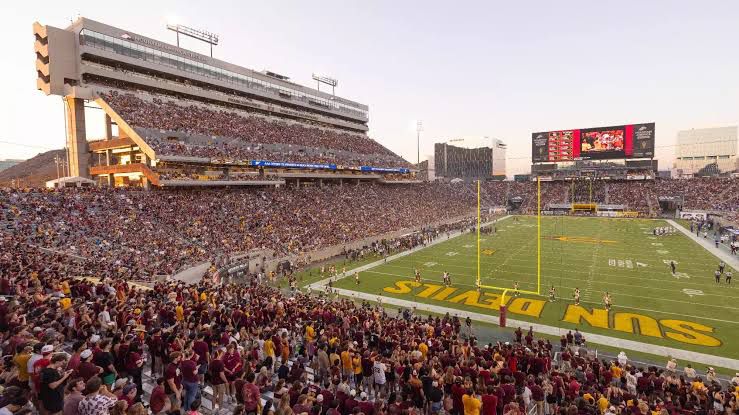For decades, Sun Devil Stadium—now renamed Mountain America Stadium—was a beacon of college football tradition, hosting Arizona State University (ASU) home games, NFL Super Bowls, and even a Pope. But as the sands of time have shifted, so too has public perception. In a scathing new ESPN report released this week, Mountain America Stadium has been named one of the worst stadiums in all of NCAA football—a stunning fall from grace that has sent shockwaves through the Sun Devil faithful and reignited concerns about the future of the program and its infrastructure.
The designation, which places Mountain America Stadium in the bottom five of ESPN’s updated 2025 “Worst Stadiums in NCAA Football” list, is based on a culmination of factors: structural degradation, subpar fan experience, outdated amenities, and a sense that the stadium—once considered elite—is now an afterthought in the rapidly modernizing landscape of college athletics. What was once iconic is now infamous.
A Storied Past, a Deteriorating Present
Opened in 1958, the stadium was once among the most forward-thinking in the western United States. Designed to hold approximately 30,000 fans, the stadium expanded over time, reaching a capacity of over 70,000 during its heyday. It hosted the Fiesta Bowl for over two decades, became the temporary home of the Arizona Cardinals, and even welcomed Pope John Paul II in 1987. With the scenic backdrop of Tempe’s buttes and the desert sun setting behind it, few college stadiums could match its visual mystique.
But as college football programs across the country poured millions—and in some cases, billions—into modernizing their facilities, Mountain America Stadium lagged behind.
“This stadium was once a fortress,” said one anonymous Pac-12 staffer interviewed in the ESPN report. “Now it feels like a relic.”
The ESPN Report: How It All Unfolded
The ESPN investigation, led by senior college football reporter Mark Schlabach, used a range of metrics to compile its annual list of the best and worst stadiums in college football. These included:
- Structural safety inspections
- Fan experience and amenities
- Accessibility and parking
- Wi-Fi and tech integration
- Concession and bathroom quality
- Interviews with players, fans, coaches, and staff
In the final analysis, Mountain America Stadium scored extremely low on nearly every metric outside of visual aesthetics.
Key Findings from ESPN’s Report:
- Structural Concerns: Multiple engineering firms contracted by the university reportedly flagged concrete stress fractures, outdated plumbing, and potential foundation weaknesses.
- Poor Fan Experience: Fans complained of cramped seating, lack of shade during early-season games, and insufficient restroom facilities.
- Lack of Modernization: Unlike peers such as Oregon’s Autzen Stadium or USC’s newly upgraded LA Coliseum, Mountain America has seen only sporadic upgrades since a partial renovation in 2015.
- Wi-Fi and Connectivity: Connectivity is virtually non-existent, making it hard for fans to check scores or post to social media.
- Player and Staff Facilities: Opposing teams and even ASU players described locker rooms as “cramped” and “barely operational.”
“In a college football world where stadiums double as high-tech entertainment complexes, Mountain America Stadium feels like a high school field with 60,000 seats,” said Schlabach.
Fan Frustration Reaches Boiling Point
For longtime ASU fans, the report merely validated what they’ve been saying for years.
“It’s embarrassing,” said Troy McIntyre, a season ticket holder since 1992. “We’re in Arizona. We should be playing in a palace, not a furnace. They’ve put Band-Aids on it for too long.”
Social media erupted with Sun Devil fans echoing the same sentiment. Posts under the hashtag #FixTheFortress began trending in the Phoenix area within hours of the ESPN report.
One viral TikTok showed a fan attempting to flush a stadium toilet only to have water spray back out—capturing, perhaps unintentionally, a metaphor for the entire experience.
Financial Struggles and Administrative Turmoil
The timing of this controversy couldn’t be worse for Arizona State. The university is grappling with financial uncertainty following the fallout of the Pac-12’s collapse and the school’s transition to the Big 12 Conference in 2024. In addition, ASU’s athletic department has faced administrative upheaval in recent years, including multiple changes in leadership and NCAA investigations that have cast a shadow over the football program.
According to the ESPN report, internal ASU documents revealed that stadium upgrades had been proposed multiple times between 2016 and 2022 but were consistently delayed or downsized due to budget constraints.
One proposed $300 million renovation plan in 2021 was shelved entirely due to lack of donor engagement and broader university financial concerns during the COVID-19 pandemic.
“It’s not that we didn’t want to improve the stadium,” said one anonymous ASU official. “It’s that we couldn’t get the financial backing. Everyone wants the bells and whistles, but no one wants to cut the check.”
Coaching Staff Reacts: “We Deserve Better”
Arizona State head coach Kenny Dillingham did not mince words when asked about the report during a press conference.
“Our players deserve better. Our fans deserve better,” Dillingham said. “We have a proud tradition here, but we’re falling behind. And if we want to compete in the Big 12, we can’t be dragging our heels on infrastructure.”
Dillingham reportedly brought up the state of the stadium in offseason meetings with university leadership, expressing concern over its impact on recruiting and player morale.
“It’s hard to bring a kid here and show them the facilities when they’ve just toured Oklahoma State or Baylor,” said one ASU assistant coach. “We’re not even in the same universe.”
The Big 12 Move: Blessing or Curse?
Arizona State’s move to the Big 12 was supposed to be a lifeline—a chance to stabilize and revitalize the football program amid the chaos of the Pac-12’s disintegration. But with the new scrutiny and higher standards comes a new spotlight, and Mountain America Stadium has proven unprepared for its close-up.
Big 12 officials reportedly conducted a facilities audit in late 2024 and advised ASU to “urgently” consider renovations if it wishes to remain competitive in the new conference environment.
“With how seriously the Big 12 takes football culture, it’s likely that continued neglect of stadium conditions could hinder ASU’s ability to grow within the league,” the ESPN report noted.
A Ray of Hope? University Response and Plans
In response to the ESPN article, Arizona State University President Dr. Michael Crow released a public statement acknowledging the stadium’s shortcomings.
“We are aware of the concerns raised and take them seriously,” Crow said. “Mountain America Stadium has a proud legacy, and we remain committed to ensuring that it remains a vibrant home for Sun Devil football and our broader community.”
Crow confirmed that ASU has begun preliminary discussions with architects and engineers on a multi-phase renovation project, expected to be unveiled in the summer of 2025. The estimated budget for Phase I is rumored to be in the $120–150 million range and would include:
- Upgraded restrooms and concession areas
- Structural repairs to concrete seating and support beams
- Installation of misting fans and additional shade
- Improved Wi-Fi and digital scoreboard systems
University officials are expected to seek funding through a mix of public-private partnerships, alumni donations, and naming rights expansions.
The Recruiting Battle: Perception Is Reality
Stadium aesthetics and facilities play an outsized role in modern college football recruiting. ESPN’s report detailed multiple anecdotes from high school recruits who viewed the stadium as a red flag.
“You walk in and it’s like stepping into a time machine,” said one four-star quarterback recruit who eventually signed with Utah. “It didn’t feel like a place built for the future.”
ASU has lost out on several top in-state and regional recruits over the last two cycles, and insiders believe the stadium’s condition played at least a partial role in those decisions.
“You can’t sell an outdated experience in an era where kids care about amenities, branding, and media,” said recruiting analyst Blair Angulo. “Mountain America Stadium is a liability.”
What Comes Next?
The backlash, while intense, may finally serve as the catalyst ASU has long needed. The ESPN spotlight, fan frustration, and looming competitive pressure from the Big 12 have converged to make inaction untenable.
In a conference where even mid-tier programs like Kansas and Texas Tech have invested heavily in their stadiums, Arizona State cannot afford to fall further behind.
The university must now decide whether it wants to return Mountain America Stadium to its former glory or watch its once-proud football heritage crumble along with its concrete.



